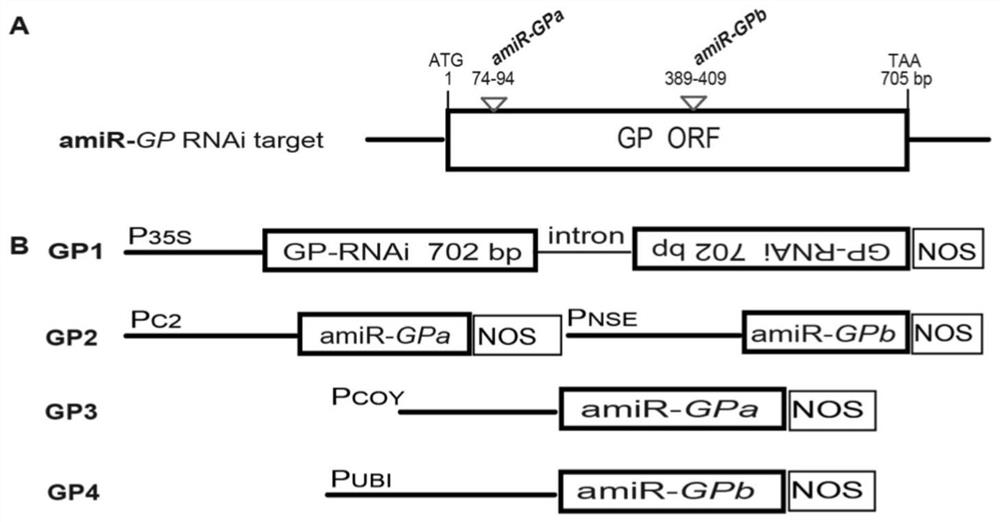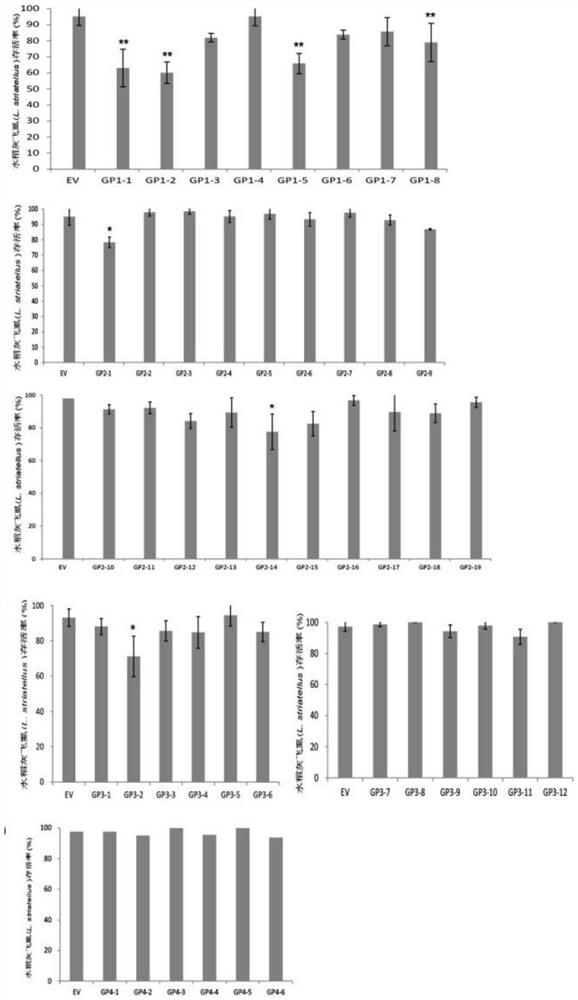The invention also discloses application of GrpE protein and coding gene thereof as molecular targets in cultivation of resistant plants
A technology of transgenic plants and genes, applied in the application field of cultivating resistant plants, can solve problems such as lack of target genes
- Summary
- Abstract
- Description
- Claims
- Application Information
AI Technical Summary
Problems solved by technology
Method used
Image
Examples
Embodiment 1
[0056] Embodiment 1, construction of recombinant plasmid
[0057] The target sequence regions of amiRGPa and amiRGPb are shown in figure 1 A.
[0058] The schematic diagrams of plasmid GP1, plasmid GP2, plasmid GP3 and plasmid GP4 are shown in figure 1 the B.
[0059] 1. Construction of GrpE gene silencing plant expression vector (GrpE-RNAi)
[0060] 1. Prepare the double-stranded DNA molecule shown in sequence 2 of the sequence listing.
[0061] 2. Using the DNA molecule in step 1 as a template, a primer pair consisting of GPa-Eco and GPa-kpn is used for PCR amplification, and the PCR amplification product is recovered.
[0062] GPa-Eco: 5'-CG GAATTC ATGGGGCCGATATCGATGTGTC-3';
[0063] GPa-kpn: 5'-GG GGTACC GGTAGCTTTTGCTTTTGAAATTCCT-3'.
[0064] 3. Take the PCR amplification product obtained in step 2, perform double digestion with restriction endonucleases EcoR I and Kpn I, and recover the digested product.
[0065] 4. Using the DNA molecule in step 1 as a templat...
Embodiment 2
[0081] Embodiment 2, preparation and identification of transgenic rice
[0082] 1. Preparation of transgenic rice
[0083] 1. Introduce the recombinant plasmid into Agrobacterium EHA105 to obtain the recombinant Agrobacterium.
[0084] 2. Co-cultivate the mature embryo callus of recombinant Agrobacterium and rice Nipponbare, then carry out resistance selection (the resistance selection adopts hygromycin at a concentration of 50 mg / L), then carry out pre-differentiation, differentiation, and rooting successively to obtain T 0 generation of regenerated plants.
[0085] 3. Take T 0 Plants are regenerated, selfed and seeds harvested.
[0086] 4. Take the seeds obtained in step 3 and culture them in a medium containing 50 mg / L hygromycin to screen for T. 1 Substitute plants.
[0087] 5. Cultivate normal growing T 1 Transgenic plants were generated, selfed and seeds were harvested.
[0088] 6. Take the seeds obtained in step 5 and culture them in a medium containing 50 mg / L ...
PUM
 Login to View More
Login to View More Abstract
Description
Claims
Application Information
 Login to View More
Login to View More - Generate Ideas
- Intellectual Property
- Life Sciences
- Materials
- Tech Scout
- Unparalleled Data Quality
- Higher Quality Content
- 60% Fewer Hallucinations
Browse by: Latest US Patents, China's latest patents, Technical Efficacy Thesaurus, Application Domain, Technology Topic, Popular Technical Reports.
© 2025 PatSnap. All rights reserved.Legal|Privacy policy|Modern Slavery Act Transparency Statement|Sitemap|About US| Contact US: help@patsnap.com



